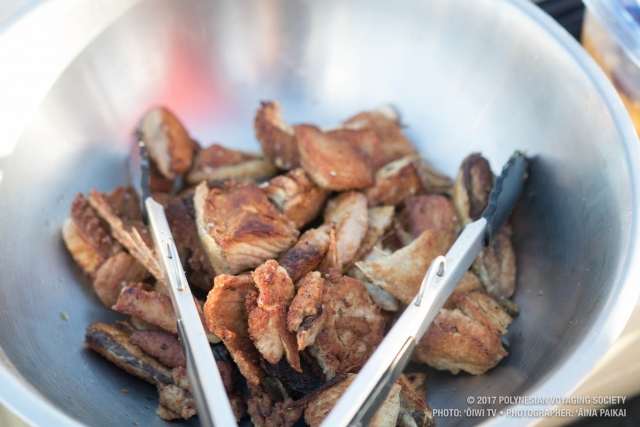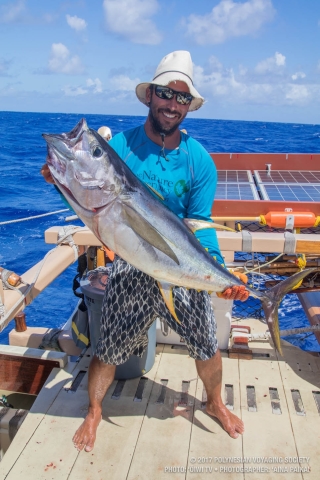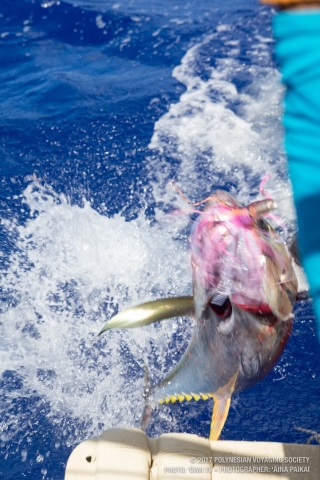
Crew Blog | ʻĀina Paikai: The Reward of Fresh Fish
- Posted on 30 Mar 2017
- In Newsletter, Photo Galleries, Teachers, Updates
 Crew blog by ʻĀina Paikai
Crew blog by ʻĀina Paikai
As apart of the 2 to 6 watch, we are blessed to see every sunrise and sunset while out on the open ocean. Each of them different and special, but none better then the last. I try not to have my eye fixed to a camera, even though these golden hours give the best lighting of the day. At least for a moment, I try to take the time to breath in the smells, soak in the colors and make it a memory… and then take the picture.
In the early hours, I’d guess around 4 or 5am, when the camera can’t capture an image the same way your eyes can, the faintest light starts to creep up from the Eastern horizon, just slightly changing the darks into what’s known in Hawaiian as wana‘ao. Each morning, right at that first light, navigator Kaleo Wong and master navigator/crew fisherman, Bruce Blankenfeld, take a short break from reading the stars and set their sight on the seas, or rather what lies beneath.
This is my first time sailing with Kaleo or Uncle Bruce, but from the footage I’ve seen, their legs seem to consistently catch. Whether in the Tasman Sea or the Atlantic Ocean, they’ve pulled up some of the most impressive monsters of the deep during the Worldwide Voyage.
Our very first day on the ocean, we snatched two mahimahi right away, satiating my expectations of fish dinners every evening, but since then, we oddly haven’t had much fish on board. Two small ahi on Day 8 served a nice breakfast, but 4 fish in 15 days seemed like a low average.
So on day 16, after repeating our same prepared dry-good meals, at least twice over now heading into the third week, I asked Kaleo if there was anything we could do to liven up our lures. He thoughtfully replied, “Pule.” So I did. I said a short prayer in my head to Kanaloa, asking him to feed this crew and offer us a fish to lift our spirits and strengthen our bodies while we continue on our long voyage to Nuku Hiva.
That afternoon, right around sunset, the snap of the rubber band caught our ears indicating something had finally taken a bite. Shortly after, Uncle Bruce pulled up a greedy little Hebi or Spearfish, whose belly was fuller than any other fish we’ve dissected. He made for a nice fried-fish and scrambled egg breakfast the following morning and some poke for lunch.
Later that day, day 17, another double strike of mahimahi hit the lines at the exact same time. Kaleo and Captain Russell Amimoto, an experienced fisherman in his own right, battled with the beasts for a bit until finally pulling them up on either sides of the deck. Both fish were nearly as tall as the men that caught them! With so much meat, we gave one of the fine fish to our escort boat crew of Gershon II. They were elated, as they hadn’t seen many bites either. We later prepared fish head soup and breaded mahimahi that was the perfect balance of moist and crunchy.
Finally, just yesterday, day 18, that resounding rubber band snap whipped everyone’s heads around. “Hanapaʻa!” Again, the captain had the duty and honor of dueling with the unknown species. This one dived down, so some had suspected an ahi. Indeed the colors of the yellow fin showed itself once it neared the surface. This one, estimated to weigh over 40 lbs, was quite the handsome fish – one that we were salivating over from the first cut.
Again with so much fish, she needed to be shared with our accompanying vessel. With just one half plus the belly, we were able to make sashimi, fried ahi, seared ahi with a furikake crust, and Kaleo fashioned a drybox so that we could dry and preserve some for a later date (Update: It’s all gone by day 19). The estimated market value per crewmember must’ve been nearly $50 a head.
At dusk, with our bellies round and full, the glow from our faces matched the warmth of the setting sun. The reward of fresh fish is the invigorating boost to the body and soul that sustains us, especially in our most trying days during a long distance voyage. We are grateful with every catch and only take what we can eat, reeling in the lines after each obtained fish. This subsistence style is the same as our voyaging ancestors, and we mahalo them for our skill in seafaring and showing us how to eat from the ocean.
We’ve nearly rounded the Earth in the name of Mālama Honua or to care for our environment, especially our surrounding seas. These gifts from Kanaloa are a reminder for us islanders that in order to eat, breathe, and live the way we know how, protecting the ocean is the key.
Hōkūle‘a Homecoming – Save the Date
Sign up for updates and be the first to know as we continue to detail homecoming festivities during the week of Hōkūleʻa’s homecoming
in June 2017!













